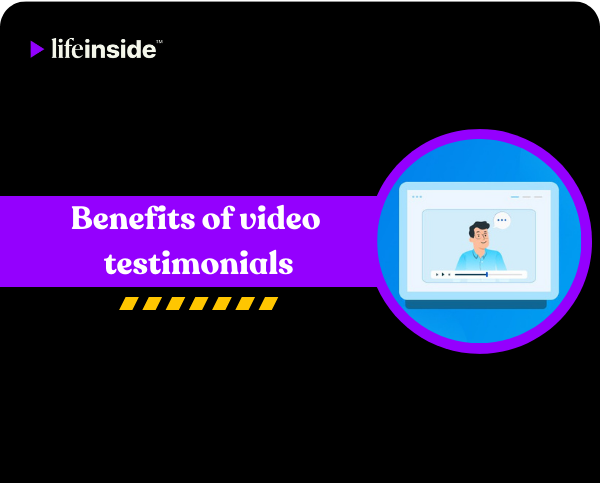Your organization’s branding can determine the type of prospects you attract. It’s not just about doing a job anymore—employees want to be associated with a great work culture that fosters trust and their growth.
This is where employer branding comes into play.
With the right branding, you can communicate your organization’s values and vision with clarity. But how you ensure employer branding also has far-reaching consequences. Your brand pitch won’t be enough to convince prospects.
Instead, candidates want to hear about the company from present and former employees. They trust their words more than those of the brand, since they get ground-level insights about your company’s culture. With the right user-generated videos, you can effectively propagate your brand’s message to humanize the organization and attract top talent.
So, in this post, we’ll discuss how you can use employee-generated content for employer branding!
What is User-generated Video for Employer Branding?
User-generated video (UGV) for employer branding entails videos created by an organization’s current employees. In these videos, the employees discuss their experiences, roles and responsibilities, and the work culture of the organization. The opinions given in the videos must be those of the employees themselves to maintain authenticity.
Bear in mind that the only level of control that the organization has over these videos is that of providing guided initiatives. They cannot direct or script the videos, as this would formalize the content.
If done correctly, UGVs can build trust and credibility with prospects and attract the best talent. Moreover, since these videos tend to be created by people who are living your brand’s work culture on a daily basis, they can create a better emotional connection and generate more engagement.
For example, you can create “A Day in the Life” vlogs, which discuss a particular employee’s roles and daily responsibilities. This can give a transparent idea about similar positions, the amenities, and the general atmosphere of the organization to prospects.
UGVs are changing the way that candidates consider organizations for career growth. Here are a few statistics that are worth mentioning:
- A whopping 88% of job seekers consider employer branding when applying for jobs (LinkedIn)
- 72% of experienced recruiters believe that employer branding is crucial for attracting the right talent (LinkedIn)
- Employees who feel connected to an organization’s mission and values are 67% more engaged than their peers (Gallup)
These statistics indicate that your employer brand has become crucial in engaging your present employees and ensuring a steady flow of strong candidates.
Benefits of User-generated Video in Employer Branding
Now, let’s discuss in detail how UGVs can change the way your organization is perceived by prospective candidates:
- Authenticity and Credibility: Whether it’s your current employees or future candidates, everyone values authenticity in the workplace. People are tired of polished brand messaging that doesn’t deliver real-world value. With UGVs, you can rectify this and enable your employees to discuss their workplace experiences. Since these videos are more informal in nature, and come directly from the current employees, they create a sense of authenticity. This leads to better brand credibility and engagement.
- Higher Engagement and Reach: Speaking of engagement, UGVs are known to offer much higher engagement than brand videos. In fact, if you combine the two, you’ll get up to 28% more engagement than just branded content. Basically, UGVs provide social proof that resonates with your target audience, leading to better emotional connections.
- Cost-effective Branding Strategy: Since UGVs are created through existing employees and can be done with minimal marketing or branding effort, they’re highly economical in the long run. Despite this, they provide a high ROI when compared to branded marketing content.
- Stronger Employee Advocacy: Your employees are the true advocates of your brand. If most of your employees are unhappy, you’ll notice lower ratings on platforms like Glassdoor, which can deter future candidates from applying. However, with UGVs, your employees are talking directly to the audience about their positive experiences and insights. This gives candidates a much clearer picture of what goes on behind the scenes, and why your organization is worth joining.
How to Encourage Employees to Create Videos
Your employees won’t just create videos for the company just at a single say-so. Here’s how you can encourage them to create employer branding videos:
Create a Supportive Space
If employees truly want to give an authentic review of your organization, you’ll have to allow them a certain level of freedom. Employees are often scared that any minor disagreement with an organization’s culture or policies can make them lose their jobs.
Instead, give them the space to speak their minds. You can add a few questions as prompts to ensure that any criticism can be structured as constructive. The idea behind this is to not judge them as “unprofessional”. Rather, highlight human moments that can resonate with other employees and the audience.
Prompting or Guiding
Your employees won’t know what to talk about without some level of guidance. Ask your marketing team to prepare some prompts or questions that the employees can refer to and answer in the videos. Let upper management be looped in on the questions and approve them.
This way, the entire process remains transparent, and your employees know exactly what to address in their employer branding videos.
Simplify the Process
Nobody’s going to create your employer branding videos if the process is complex. If you ask them to download an app or edit the videos before submitting, you’re inviting friction. This discourages employees due to the level of work involved.
Instead, tell them to create simple, selfie-styled videos that don’t require edits from their end. Create a form or add a link through which they can upload and send their videos.
Interactive video platforms like Life Inside automate the video collection process through QR codes. Employees can create their videos, scan the QR code, and upload them directly to the portal for easy collection!
Provide Incentives and Recognize Efforts
Even a basic amount of recognition can go a long way to boost employee morale. You can shout out employees’ videos in meetings, appreciate their hard work over email, and even share their videos on social media (while tagging them).
Employees who are consistently creating employer branding videos or advocating for the organization can also be rewarded in different ways. You can provide them a half-day leave on a date of their choice, provide a cash reward, and so much more.
Measuring the Success of User-generated Video Content
So, you’ve created your UGVs and distributed them on your channels. But how do you know that they’re providing the right results?
Key Performance Indicators (KPIs)
Define your goal with the UGVs before setting the KPIs. Do you want more visibility or to increase the average number of applications?
Some common metrics for any goal would be the following:
- Number of videos created
- View counts across distribution channels
- Employee participation rates
- Shares or reposts
Of course, more specific metrics to track will depend on your goal with the UGVs.
Engagement Metrics and Feedback
Thanks to social media, there are easy ways to track engagement on your videos. Monitor the following:
- Likes, Shares, Comments
- Average Watch Times
- Reshares with Brand Mentions
You can also add feedback elements in your interactive videos to acquire feedback, such as:
-
Did the videos compel them to check out the brand’s Careers page?
-
Were they convinced about applying for certain roles due to the video?
Conversion and Recruitment Impact
Ultimately, the main goal of the videos is to convert and have a positive impact on your brand’s recruitment metrics. Check if the videos led to better application quality or more applications in general.
Track how the Careers page engagement has changed post-video publishing, and how many are visiting the page directly through the video.
In the longer run, it’s important to measure the cost-per-hire after the videos have been published.
Common Challenges and How to Overcome Them
While you’re getting ready to implement UGVs, there are a few issues that you might encounter during the process. Luckily for you, we’ve outlined these issues and their fixes right here:
Maintaining Brand Consistency
While UGVs need to be informal and slightly unpolished for authenticity, the problem of brand consistency can pop up. To fix this, here’s what you can do:
- Establish a guideline for the tone you need, the topics you’d like them to talk about, and the length of the video.
- You can also provide a branded intro or outro template for the final video
- Ensure that the marketing team is available to edit the videos slightly for a consistent brand tone
Encouraging Participation
We’ve already outlined how you can encourage participation from your employees in an earlier section. But we’ve mentioned it here because this is a genuine issue that can affect your employer branding process.
Remember to start small and make it a basic part of their onboarding training. You can also carry out an exercise in this once every quarter. This not only increases their confidence but you also get an insight into how the organization’s processes can be improved.
To sum up, ensure that the employees have a safe space to talk about their experiences, and recognize them for the effort that they put into the videos.
Handling Negative Content
If you want your employees to give their authentic reviews of your workplace, you’ll have to prepare for a few negative reviews as well.
- Create a light guideline on how to create the video and what to talk about. Be transparent and communicate which topics are off the table.
- Ensure that there’s a review process after every video has been submitted. However, don’t censor heavily, as this would defeat the video’s purpose.
- If there’s any feedback from the employees in their videos, address them directly and see how you can improve on the said points.
How Life Inside Can Help You With Employer Branding?
Life Inside is an interactive video platform that helps you create, collect, and automate the distribution of your interactive videos. It allows you to create employee testimonial videos in your recruitment and marketing funnels, with interactive elements for audience engagement and feedback.
In the earlier sections, we discussed how Life Inside automates the video creation and collection process. It also provides analytics for watch times and engagement rates, especially during A/B testing, to help you understand what’s working and what needs improvement.
Plus, the interactivity of these videos turns your audience (prospective candidates) into active participants in the video's narrative. With feedback forms, polls, and CTA buttons, they get to ask questions, provide their input, and check out your Careers page. This entire setup eliminates friction while adding brand credibility and trust.
So, if you want to experience the future of employer branding and video marketing, sign up for Life Inside today!
Frequently Asked Questions
1. What are some examples of successful employer branding through video?
Some successful employer branding examples include those of HubSpot and Zendesk. These companies created “day in the life” videos through the lens of their employees, giving the audience a glimpse into how each company functions and supports employee growth.
-
2. How can companies maintain brand consistency in user-generated videos?
Companies can provide a guideline, provide editing support through marketing, and add some light templates for the videos. This ensures that the employees know what to discuss, and the final video maintains the brand’s tone.
3. How does user-generated video enhance employer branding?
User-generated video provides an authentic and transparent look into the organization’s culture, mission, values, and employee environment. Since these videos are informal and created with the help of employees, prospects and the general audience trust these videos more than branded messaging. This leads to higher brand trust, credibility, and engagement.




